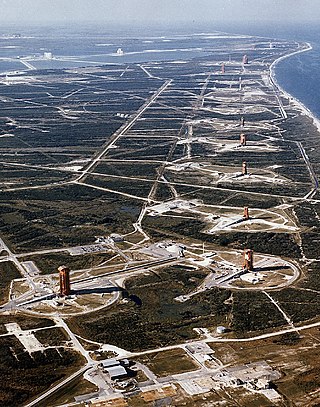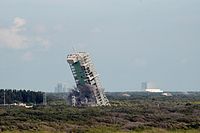
The John F. Kennedy Space Center, located on Merritt Island, Florida, is one of the National Aeronautics and Space Administration's (NASA) ten field centers. Since 1968, KSC has been NASA's primary launch center of American spaceflight, research, and technology. Launch operations for the Apollo, Skylab and Space Shuttle programs were carried out from Kennedy Space Center Launch Complex 39 and managed by KSC. Located on the east coast of Florida, KSC is adjacent to Cape Canaveral Space Force Station (CCSFS). The management of the two entities work very closely together, share resources, and operate facilities on each other's property.

Cape Canaveral Space Force Station (CCSFS) is an installation of the United States Space Force's Space Launch Delta 45, located on Cape Canaveral in Brevard County, Florida.

Blue Origin Enterprises, L.P., commonly referred to as Blue Origin, is an American aerospace manufacturer and launch service provider. The company makes rocket engines for United Launch Alliance's Vulcan rocket and is currently operating its suborbital reusable New Shephard vehicle. Blue Origin is developing its heavy-lift launch vehicle named New Glenn, the Blue Moon human lunar lander for NASA's Artemis program, and Orbital Reef space station in partnership with other companies.

Launch Complex 39A (LC-39A) is the first of Launch Complex 39's three launch pads, located at NASA's Kennedy Space Center in Merritt Island, Florida. The pad, along with Launch Complex 39B, was first constructed in the 1960s to accommodate the Saturn V launch vehicle, and has been used to support NASA crewed space flight missions, including the historic Apollo 11 moon landing and the Space Shuttle. The site is currently leased by SpaceX and supports launches of the Falcon 9 and Falcon Heavy rockets.

The Atlas-Centaur was a United States expendable launch vehicle derived from the SM-65 Atlas D missile. The vehicle featured a Centaur upper stage, the first such stage to use high-performance liquid hydrogen as fuel. Launches were conducted from Launch Complex 36 at the Cape Canaveral Air Force Station (CCAFS) in Florida. After a strenuous flight test program, Atlas-Centaur went on to launch several crucial spaceflight missions for the United States, including Surveyor 1, and Pioneer 10/11. The vehicle would be continuously developed and improved into the 1990s, with the last direct descendant being the highly successful Atlas II.

Launch Complex 39 (LC-39) is a rocket launch site at the John F. Kennedy Space Center on Merritt Island in Florida, United States. The site and its collection of facilities were originally built as the Apollo program's "Moonport" and later modified for the Space Shuttle program. Launch Complex 39 consists of three launch sub-complexes or "pads"—39A, 39B, and 39C—a Vehicle Assembly Building (VAB), a Crawlerway used by crawler-transporters to carry mobile launcher platforms between the VAB and the pads, Orbiter Processing Facility buildings, a Launch Control Center which contains the firing rooms, a news facility famous for the iconic countdown clock seen in television coverage and photos, and various logistical and operational support buildings.

United Launch Alliance, LLC (ULA) is an American launch service provider formed in December 2006 as a joint venture between Lockheed Martin Space and Boeing Defense, Space & Security. The company designs, assembles, sells and launches rockets, but the company subcontracts out the production of rocket engines and solid rocket boosters.

Space Launch Complex 41 (SLC-41), previously Launch Complex 41 (LC-41), is an active launch site at Cape Canaveral Space Force Station. As of 2024, the site is used by United Launch Alliance (ULA) for Atlas V and Vulcan Centaur launches. Previously, it had been used by the United States Air Force for Titan IIIC, Titan IIIE, and Titan IV launches.

Launch Complex 39B (LC-39B) is the second of Launch Complex 39's three launch pads, located at NASA's Kennedy Space Center in Merritt Island, Florida. The pad, along with Launch Complex 39A, was first designed for the Saturn V launch vehicle, which at the time was the United States' most powerful rocket. Typically used to launch NASA's crewed spaceflight missions since the late 1960s, the pad is currently configured for use by the agency's Space Launch System rocket, a Shuttle-derived launch vehicle which is currently used in the Artemis program and subsequent Moon to Mars campaigns. The pad had also been leased by NASA to aerospace company Northrop Grumman, for use as a launch site for their Shuttle-derived OmegA launch vehicle, for National Security Space Launch flights and commercial launches, before the OmegA program was cancelled.

Missile Row was a nickname given in the 1960s to the eight SM-65 Atlas and HGM-25A Titan I launch complexes at the middle area of Cape Canaveral Space Force Station (CCSFS), historically used by the United States Air Force and NASA. Operated by the 45th Space Wing since 1949, it was the site of all fourteen Mercury-Atlas and Gemini launches, as well as many other early missile tests, Department of Defense (DoD) launches, and NASA launches. For the DoD, it played a secondary role to Vandenberg Air Force Base in California, but was the launch site for many NASA unmanned space probes, as those spacecraft were typically launched on military launchers.

Launch Complex 11 (LC-11) at Cape Canaveral Space Force Station, Florida, is a launch complex used by Atlas missiles between 1958 and 1964. It is the southernmost of the launch pads known as Missile Row. When it was built, it, along with complexes 12, 13 and 14, featured a more robust design than many contemporary pads, due to the greater power of the Atlas compared to other rockets of the time. It was larger, and featured a concrete launch pedestal that was 6 metres (20 ft) tall and a reinforced blockhouse. The rockets were delivered to the launch pad by a ramp on the southwest side of the launch pedestal.

Launch Complex 12 (LC-12) at Cape Canaveral Space Force Station, Florida was a launch pad used by Atlas rockets and missiles between 1958 and 1967. It was the second-most southern of the pads known as Missile Row, between LC-11 to the south and LC-13 to the north. Along with Complexes 11, 13 and 14, LC-12 featured a more robust design than many contemporary pads, due to the greater power of the Atlas compared to other rockets of the time. It was larger, and featured a concrete launch pedestal that was 6 metres (20 ft) tall and a reinforced blockhouse. The rockets were delivered to the launch pad by means of a ramp on the southwest side of the launch pedestal.

Launch Complex 13 (LC-13) was a launch complex at Cape Canaveral Space Force Station (CCAS), the third-most southerly of the original launch complexes known as Missile Row, lying between LC-12 and LC-14. In 2015, the LC-13 site was leased by SpaceX and was renovated for use as Landing Zone 1 and Landing Zone 2, the company's East Coast landing location for returning Falcon 9 and Falcon Heavy launch vehicle booster stages. It is leased by US Space Force to Phantom Space and Vaya Space who will operate this launch complex after the termination of SpaceX's lease in future.

As of 2023, SpaceX operates four launch facilities: Cape Canaveral Space Launch Complex 40 (SLC-40), Vandenberg Space Force Base Space Launch Complex 4E (SLC-4E), Kennedy Space Center Launch Complex 39A (LC-39A), and Brownsville South Texas Launch Site (Starbase). Space Launch Complex 40 was damaged in the AMOS-6 accident in September 2016 and repair work was completed by December 2017. SpaceX believes that they can optimize their launch operations, and reduce launch costs, by dividing their launch missions amongst these four launch facilities: LC-39A for NASA launches, SLC-40 for United States Space Force national security launches, SLC-4E for polar launches, and South Texas Launch Site for commercial launches.

New Glenn is a heavy-lift launch vehicle developed by Blue Origin, named after NASA astronaut John Glenn, the first American astronaut to orbit Earth. New Glenn is a two-stage rocket with a diameter of 7 m (23 ft). Its first stage is powered by seven BE-4 engines that are also designed and manufactured by Blue Origin. It is intended to launch from Cape Canaveral Launch Complex 36, with the first stage landing on a barge called Landing Platform Vessel 1. The inaugural vehicle was unveiled on the launch pad in February 2024.
The private aerospace company Blue Origin has a number of development, manufacturing, and test facilities in four US states: Washington, Texas, Florida, and Alabama.
Jacklyn, formerly known as LPV, Stena Freighter, Stena Seafreighter, RFA Sea Chieftain, and originally Stena Hispanica, was a roll-on/roll-off cargo ship which was purchased by Blue Origin in 2018 for use as a landing platform ship. Ultimately, Blue Origin abandoned their plans to use the ship as a landing platform, and in August 2022, the ship was towed to the Port of Brownsville for scrapping.



















